Projections of Urban Heat Island Effects Under Future Climate Scenarios: A Case Study in Zhengzhou, China
Abstract
1. Introduction
2. Materials and Methods
2.1. Study Area
2.2. Model Setup
2.3. Future Climate Scenarios
2.4. Experimental Design
2.5. Datasets
2.6. Method of Model Evaluation
3. Results
3.1. Model Performance
3.2. Spatial and Seasonal Variations in Temperature
3.3. Temperature Changes Under SSP Scenarios
3.4. Impact of Future Climate on the UHI Effect
4. Discussion
5. Conclusions
Author Contributions
Funding
Data Availability Statement
Conflicts of Interest
References
- Diem, P.K.; Nguyen, C.T.; Diem, N.K.; Diep, N.T.H.; Thao, P.T.B.; Hong, T.G.; Phan, T.N. Remote sensing for urban heat island research: Progress, current issues, and perspectives. Remote Sens. Appl. Soc. Environ. 2024, 33, 101081. [Google Scholar] [CrossRef]
- Elnabawi, M.H.; Raveendran, R. Meta-pragmatic investigation of passive strategies from ‘UHI– climatology’ nexus perspective with digital twin as assessment mechanism. J. Urban Manag. 2024, 13, 332–356. [Google Scholar] [CrossRef]
- Xu, X.; Dong, Q.; Zhen, M. Assessing effects of future climate change on outdoor thermal stress and building energy performance in severe cold region of China. Build. Environ. 2024, 251, 111236. [Google Scholar] [CrossRef]
- Xu, D.; Wang, Y.; Zhou, D.; Wang, Y.; Zhang, Q.; Yang, Y. Influences of urban spatial factors on surface urban heat island effect and its spatial heterogeneity: A case study of Xi’an. Build. Environ. 2024, 248, 111072. [Google Scholar] [CrossRef]
- Zhong, Y.; Li, S.; Liang, X.; Guan, Q. Causal inference of urban heat island effect and its spatial heterogeneity: A case study of Wuhan, China. Sustain. Cities Soc. 2024, 115, 105850. [Google Scholar] [CrossRef]
- Alexander, C. Influence of the proportion, height and proximity of vegetation and buildings on urban land surface temperature. Int. J. Appl. Earth Obs. Geoinf. 2021, 95, 102265. [Google Scholar] [CrossRef]
- Gao, Y.; Zhao, J.; Yu, K. Effects of block morphology on the surface thermal environment and the corresponding planning strategy using the geographically weighted regression model. Build. Environ. 2022, 216, 109037. [Google Scholar] [CrossRef]
- Deilami, K.; Kamruzzaman, M.; Liu, Y. Urban heat island effect: A systematic review of spatio-temporal factors, data, methods, and mitigation measures. Int. J. Appl. Earth Obs. Geoinf. 2018, 67, 30–42. [Google Scholar] [CrossRef]
- Kwok, Y.T.; Ng, E.Y.Y. Trends, topics, and lessons learnt from real case studies using mesoscale atmospheric models for urban climate applications in 2000–2019. Urban Clim. 2021, 36, 100785. [Google Scholar] [CrossRef]
- Sahoo, S.; Majumder, A.; Swain, S.; Gareema; Pateriya, B.; Al-Ansari, N. Analysis of Decadal Land Use Changes and Its Impacts on Urban Heat Island (UHI) Using Remote Sensing-Based Approach: A Smart City Perspective. Sustainability 2022, 14, 11892. [Google Scholar] [CrossRef]
- Zhou, D.; Sun, S.; Li, Y.; Zhang, L.; Huang, L. A multi-perspective study of atmospheric urban heat island effect in China based on national meteorological observations: Facts and uncertainties. Sci. Total Environ. 2023, 854, 158638. [Google Scholar] [CrossRef]
- Morris, C.J.G.; Simmonds, I.; Plummer, N. Quantification of the influences of wind and cloud on the nocturnal urban heat island of a large city. J. Appl. Meteorol. 2001, 40, 169–182. [Google Scholar] [CrossRef]
- Zhou, D.; Xiao, J.; Bonafoni, S.; Berger, C.; Deilami, K.; Zhou, Y.; Frolking, S.; Yao, R.; Qiao, Z.; Sobrino, J.A. Satellite Remote Sensing of Surface Urban Heat Islands: Progress, Challenges, and Perspectives. Remote Sens. 2019, 11, 48. [Google Scholar] [CrossRef]
- Liang, K.; Ren, X.; Zhang, Y.; Liu, W.; Li, H. Analysis of urban heat island and land cover spatiotemporal changes in the Pearl River Delta urban agglomeration. Geospat. Inf. 2022, 20, 36–40. [Google Scholar] [CrossRef]
- Michau, Y.; Lemonsu, A.; Lucas-Picher, P.; Caillaud, C. Evaluation of the Urban Heat Island of 12 cities of France in a high-resolution regional climate model simulation. Urban Clim. 2023, 47, 101386. [Google Scholar] [CrossRef]
- Zhao, Y.; Zhong, L.; Ma, Y.; Fu, Y.; Chen, M.; Ma, W.; Zhao, C.; Huang, Z.; Zhou, K. WRF/UCM simulations of the impacts of urban expansion and future climate change on atmospheric thermal environment in a Chinese megacity. Clim. Change 2021, 169, 38. [Google Scholar] [CrossRef]
- Schwingshackl, C.; Daloz, A.S.; Iles, C.; Aunan, K.; Sillmann, J. High-resolution projections of ambient heat for major European cities using different heat metrics. Nat. Hazards Earth Syst. Sci. 2024, 24, 331–354. [Google Scholar] [CrossRef]
- Ilhamsyah, Y. A Mesoscale Meteorological Model of Modified Land Cover to the Effect of Urban Heat Island in Jakarta, Indonesia. Aceh Int. J. Sci. Technol. 2012, 1, 60–66. [Google Scholar] [CrossRef]
- He, Y.; Yuan, C.; Ren, C.; Wang, W.; Shi, Y.; Ng, E. Urban ventilation assessment with improved vertical wind profile in high-density cities—Investigations in nighttime extreme heat. Build. Environ. 2022, 216, 109018. [Google Scholar] [CrossRef]
- Park, K.; Baik, J.-J.; Jin, H.-G.; Tabassum, A. Changes in urban heat island intensity with background temperature and humidity and their associations with near-surface thermodynamic processes. Urban Clim. 2024, 58, 102191. [Google Scholar] [CrossRef]
- Zhang, H.; Zhang, X.; Fan, G. Numerical simulation study on the impact of urbanization on the thermal environment of Hangzhou city. Chin. Environ. Sci. 2021, 41, 4107–4119. [Google Scholar] [CrossRef]
- Wu, S.; Wang, P.; Tong, X.; Tian, H.; Zhao, Y.; Luo, M. Urbanization-driven increases in summertime compound heat extremes across China. Sci. Total Environ. 2021, 799, 149166. [Google Scholar] [CrossRef]
- Kusaka, H.; Suzuki-Parker, A.; Aoyagi, T.; Adachi, S.A.; Yamagata, Y. Assessment of RCM and urban scenarios uncertainties in the climate projections for August in the 2050s in Tokyo. Clim. Change 2016, 137, 427–438. [Google Scholar] [CrossRef]
- Argüeso, D.; Evans, J.P.; Fita, L.; Bormann, K.J. Temperature response to future urbanization and climate change. Clim. Dyn. 2014, 42, 2183–2199. [Google Scholar] [CrossRef]
- Hamdi, R.; Van de Vyver, H.; De Troch, R.; Termonia, P. Assessment of three dynamical urban climate downscaling methods: Brussels’s future urban heat island under an A1B emission scenario. Int. J. Clim. 2014, 34, 978–999. [Google Scholar] [CrossRef]
- Nazarenko, L.; Schmidt, G.A.; Miller, R.L.; Tausnev, N.; Kelley, M.; Ruedy, R.; Russell, G.L.; Aleinov, I.; Bauer, M.; Bauer, S.; et al. Future climate change under RCP emission scenarios with GISS M odelE2. J. Adv. Model. Earth Syst. 2015, 7, 244–267. [Google Scholar] [CrossRef]
- Lee, J.W.; Hong, S.Y.; Chang, E.C.; Suh, M.-S.; Kang, H.-S. Assessment of future climate change over East Asia due to the RCP scenarios downscaled by GRIMs-RMP. Clim. Dyn. 2014, 42, 733–747. [Google Scholar] [CrossRef]
- Zou, J.; Lu, H.; Shu, C.; Ji, L.; Gaur, A.; Wang, L. Multiscale numerical assessment of urban overheating under climate projections: A review. Urban Clim. 2023, 49, 101551. [Google Scholar] [CrossRef]
- Henan Provincial People’s Government. Statistical Bulletin on National Economic and Social Development of Zhengzhou City. Available online: www.henan.gov.cn (accessed on 15 April 2024).
- Dayal, K.K.; Bellon, G.; Cater, J.E.; Kingan, M.J.; Sharma, R.N. High-resolution mesoscale wind-resource assessment of Fiji using the Weather Research and Forecasting (WRF) model. Energy 2021, 232, 121047. [Google Scholar] [CrossRef]
- Nooni, I.K.; Tan, G.; Hongming, Y.; Saidou Chaibou, A.A.; Habtemicheal, B.A.; Gnitou, G.T.; Lim Kam Sian, K.T.C. Assessing the Performance of WRF Model in Simulating Heavy Precipitation Events over East Africa Using Satellite-Based Precipitation Product. Remote Sens. 2022, 14, 1964. [Google Scholar] [CrossRef]
- Ma, M.; Tang, J.; Ou, T.; Zhou, P. High-resolution climate projection over the Tibetan Plateau using WRF forced by bias-corrected CESM. Atmos. Res. 2023, 286, 106670. [Google Scholar] [CrossRef]
- Schumacher, V.; Fernández, A.; Justino, F.; Comin, A. WRF High Resolution Dynamical Downscaling of Precipitation for the Central Andes of Chile and Argentina. Front. Earth Sci. 2020, 8, 328. [Google Scholar] [CrossRef]
- Liu, X.; Min, R.; Zhang, H.; Wang, Q.; Song, H. Land cover changes reduce dust aerosol concentrations in northern China (2000–2020). Environ. Res. 2025, 268, 120823. [Google Scholar] [CrossRef]
- Wang, T.H.; Zhang, L.; Zhou, S.H.; Zhang, T.N.; Zhai, S.Y.; Yang, Z.L.; Wang, D.; Song, H.Q. Effects of ground-level ozone pollution on yield and economic losses of winter wheat in Henan, China. Atmos. Environ. 2021, 262, 118654. [Google Scholar] [CrossRef]
- Wang, W.; Wang, Y.; Zhai, S.; Xia, H.; Wang, D.; Song, H. Climate change driven by LUCC reduced NPP in the Yellow River Basin, China. Glob. Planet. Change 2024, 242, 104586. [Google Scholar] [CrossRef]
- Zhang, H.; Wang, F.; Zhou, S.; Zhang, T.; Qi, M.; Song, H. Contribution of dust emissions from farmland to particulate matter concentrations in North China Plain: Integration of WRF-Chem and WEPS model. Environ. Int. 2025, 195, 109191. [Google Scholar] [CrossRef]
- Xu, H.; Li, X.; Yin, J.; Zhou, L.; Song, Y.; Hu, T. Microphysics affect the sensitivities of rainfall to different horizontal-resolution simulations: Evidence from a case study of the Weather Research and Forecasting model runs. Atmos. Res. 2023, 296, 107022. [Google Scholar] [CrossRef]
- Rizza, U.; Avolio, E.; Morichetti, M.; Di Liberto, L.; Bellini, A.; Barnaba, F.; Virgili, S.; Passerini, G.; Mancinelli, E. On the Interplay between Desert Dust and Meteorology Based on WRF-Chem Simulations and Remote Sensing Observations in the Mediterranean Basin. Remote Sens. 2023, 15, 435. [Google Scholar] [CrossRef]
- Khamees, A.S.; Sayad, T.; Morsy, M.; Ali Rahoma, U. Evaluation of three radiation schemes of the WRF-Solar model for global surface solar radiation forecast: A case study in Egypt. Adv. Space Res. 2024, 73, 2880–2891. [Google Scholar] [CrossRef]
- Parra, R. Assessment of Land Surface Schemes from the WRF-Chem for Atmospheric Modeling in the Andean Region of Ecuador. Atmosphere 2023, 14, 508. [Google Scholar] [CrossRef]
- Zhang, T.; Cao, L.; Li, S.; Zhan, C.; Wang, J.; Zhao, T. Comprehensive sensitivity analysis of the WRF model for meteorological simulations in the Arctic. Atmos. Res. 2024, 299, 107200. [Google Scholar] [CrossRef]
- Yang, J.; Tang, Y.; Han, S.; Liu, J.; Yang, X.; Hao, J. Evaluation and improvement study of the Planetary Boundary-Layer schemes during a high PM2.5 episode in a core city of BTH region, China. Sci. Total Environ. 2021, 765, 142756. [Google Scholar] [CrossRef]
- Hoque, M.M.; Afsar, M.S.U.; Faruque, M.R.I.; Ahmed, S.J.; Jamil, A.T.M.K.; Mallik, M.A.K.; Hassan, S.M.Q. Sensitivity analysis of cumulus parameterization scheme and data sources to simulate thunderstorms over Bangladesh using WRF model. Adv. Space Res. 2024, 74, 5383–5394. [Google Scholar] [CrossRef]
- Ru, X.; Qiao, L.; Zhang, H.; Bai, T.; Min, R.; Wang, Y.; Wang, Q.; Song, H. Effects of land use and land cover change under shared socioeconomic pathways on future climate in the Yellow River basin, China. Urban Clim. 2024, 55, 101867. [Google Scholar] [CrossRef]
- Zhang, L.; Wang, F.; Song, H.Q.; Zhang, T.N.; Wang, D.; Xia, H.M.; Zhai, S.Y.; Liu, Y.Z.; Wang, T.H.; Wang, Y.B.; et al. Effects of projected climate change on winter wheat yield in Henan, China. J. Clean. Prod. 2022, 379, 134734. [Google Scholar] [CrossRef]
- Riahi, K.; van Vuuren, D.P.; Kriegler, E.; Edmonds, J.; O’Neill, B.C.; Fujimori, S.; Bauer, N.; Calvin, K.; Dellink, R.; Fricko, O.; et al. The Shared Socioeconomic Pathways and their energy, land use, and greenhouse gas emissions implications: An overview. Glob. Environ. Change 2017, 42, 153–168. [Google Scholar] [CrossRef]
- Van Vuuren, D.P.; Edmonds, J.; Kainuma, M.; Riahi, K.; Thomson, A.; Hibbard, K.; Hurtt, G.C.; Kram, T.; Krey, V.; Lamarque, J.F.; et al. The representative concentration pathways: An overview. Clim. Change 2011, 109, 5–31. [Google Scholar] [CrossRef]
- Mora, C.; Spirandelli, D.J.; Franklin, E.C.; Lynham, J.M.; Kantar, M.B.; Miles, W.B.; Smith, C.Z.; Freel, K.C.; Moy, J.; Louis, L.V.; et al. Broad threat to humanity from cumulative climate hazards intensified by greenhouse gas emissions. Nat. Clim. Change 2018, 8, 1062–1071. [Google Scholar] [CrossRef]
- Chen, G.; Li, X.; Liu, X. Global land projection based on plant functional types with a 1-km resolution under socio-climatic scenarios. Sci. Data 2022, 9, 125. [Google Scholar] [CrossRef]
- Xu, Z.; Han, Y.; Tam, C.Y.; Yang, Z.L.; Fu, C. Bias-corrected CMIP6 global dataset for dynamical downscaling of the historical and future climate (1979–2100). Sci. Data 2021, 8, 293. [Google Scholar] [CrossRef]
- Song, H.; Wang, K.; Zhang, Y.; Hong, C.; Zhou, S. Simulation and evaluation of dust emissions with WRF-Chem (v3.7.1) and its relationship to the changing climate over East Asia from 1980 to 2015. Atmos. Environ. 2017, 167, 511–522. [Google Scholar] [CrossRef]
- Zhao, L.; Oppenheimer, M.; Zhu, Q.; Baldwin, J.W.; Ebi, K.L.; Bou-Zeid, E.R.; Guan, K.; Liu, X. Interactions between urban heat islands and heat waves. Environ. Res. Lett. 2018, 13, 034003. [Google Scholar] [CrossRef]
- Barkhordarian, A. Attribution of extremes to greenhouse gas-induced changes in regional climate variability, distinct from changes in mean climate. Environ. Res. Lett. 2024, 19, 104022. [Google Scholar] [CrossRef]
- Kotharkar, R.; Bagade, A.; Ramesh, A. Assessing urban drivers of canopy layer urban heat island: A numerical modeling approach. Landsc. Urban Plan. 2019, 190, 103586. [Google Scholar] [CrossRef]
- IPCC. Climate Change 2021: The Physical Science Basis. In Contribution of Working Group I to the Sixth Assessment Report of the IPCC; Cambridge University Press: Cambridge, UK, 2021. [Google Scholar]
- Krayenhoff, E.S.; Broadbent, A.M.; Zhao, L.; Georgescu, M.; Middel, A.; Voogt, J.A.; Martilli, A.; Sailor, D.J.; Erell, E. Cooling hot cities: A systematic and critical review of the numerical modelling literature. Environ. Res. Lett. 2021, 16, 053007. [Google Scholar] [CrossRef]
- Li, Y.; Sun, Y.; Li, J.; Gao, C. Socioeconomic drivers of urban heat island effect: Empirical evidence from major Chinese cities. Sustain. Cities Soc. 2020, 63, 102425. [Google Scholar] [CrossRef]
- Santamouris, M. On the energy impact of urban heat island and global warming on buildings. Energy Build. 2014, 82, 100–113. [Google Scholar] [CrossRef]
- Santamouris, M. Analyzing the heat island magnitude and characteristics in one hundred Asian and Australian cities and regions. Sci. Total Environ. 2015, 512–513, 582–598. [Google Scholar] [CrossRef]
- Li, Y.; Yang, T.; Zhao, G.; Ma, C.; Yan, Y.; Xu, Y.; Wang, L.; Wang, L. A systematic review of studies involving canopy layer urban heat island: Monitoring and associated factors. Ecol. Indic. 2024, 158, 111424. [Google Scholar] [CrossRef]
- Samra, R.M.A. Investigating and mapping day-night urban heat island and its driving factors using Sentinel/MODIS data and Google Earth Engine. Case study: Greater Cairo, Egypt. Urban Clim. 2023, 52, 101729. [Google Scholar] [CrossRef]
- Siddiqui, A.; Kushwaha, G.; Nikam, B.; Srivastav, S.K.; Shelar, A.; Kumar, P. Analysing the day/night seasonal and annual changes and trends in land surface temperature and surface urban heat island intensity (SUHII) for Indian cities. Sustain. Cities Soc. 2021, 75, 103374. [Google Scholar] [CrossRef]
- Abbassi, Y.; Ahmadikia, H.; Baniasadi, E. Impact of wind speed on urban heat and pollution islands. Urban Clim. 2022, 44, 101200. [Google Scholar] [CrossRef]
- Du, R.; Liu, C.H.; Li, X.; Lin, C.Y. Interaction among local flows, UHI, coastal winds, and complex terrain: Effect on urban-scale temperature and building energy consumption during heatwaves. Energy Build. 2024, 303, 113763. [Google Scholar] [CrossRef]
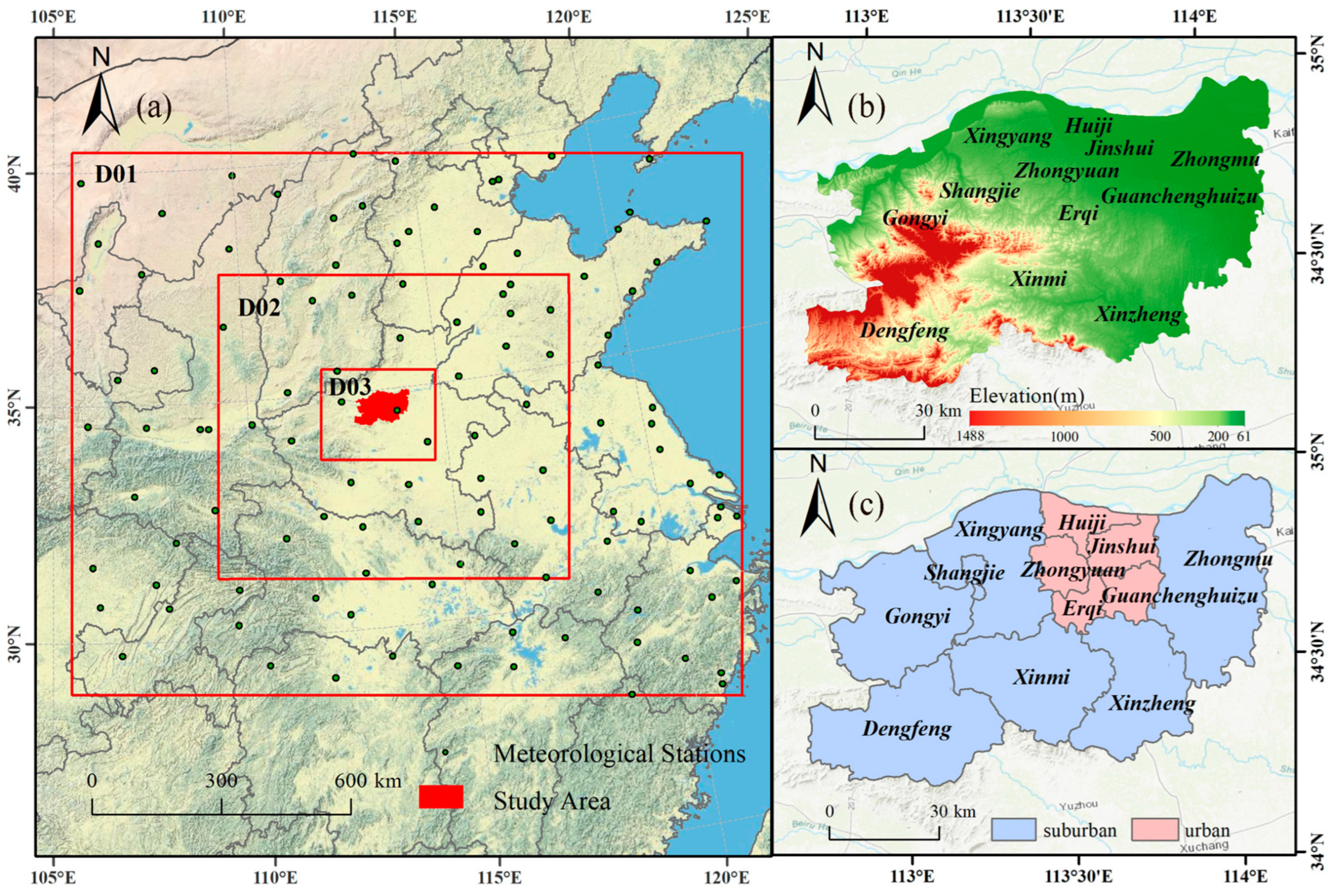
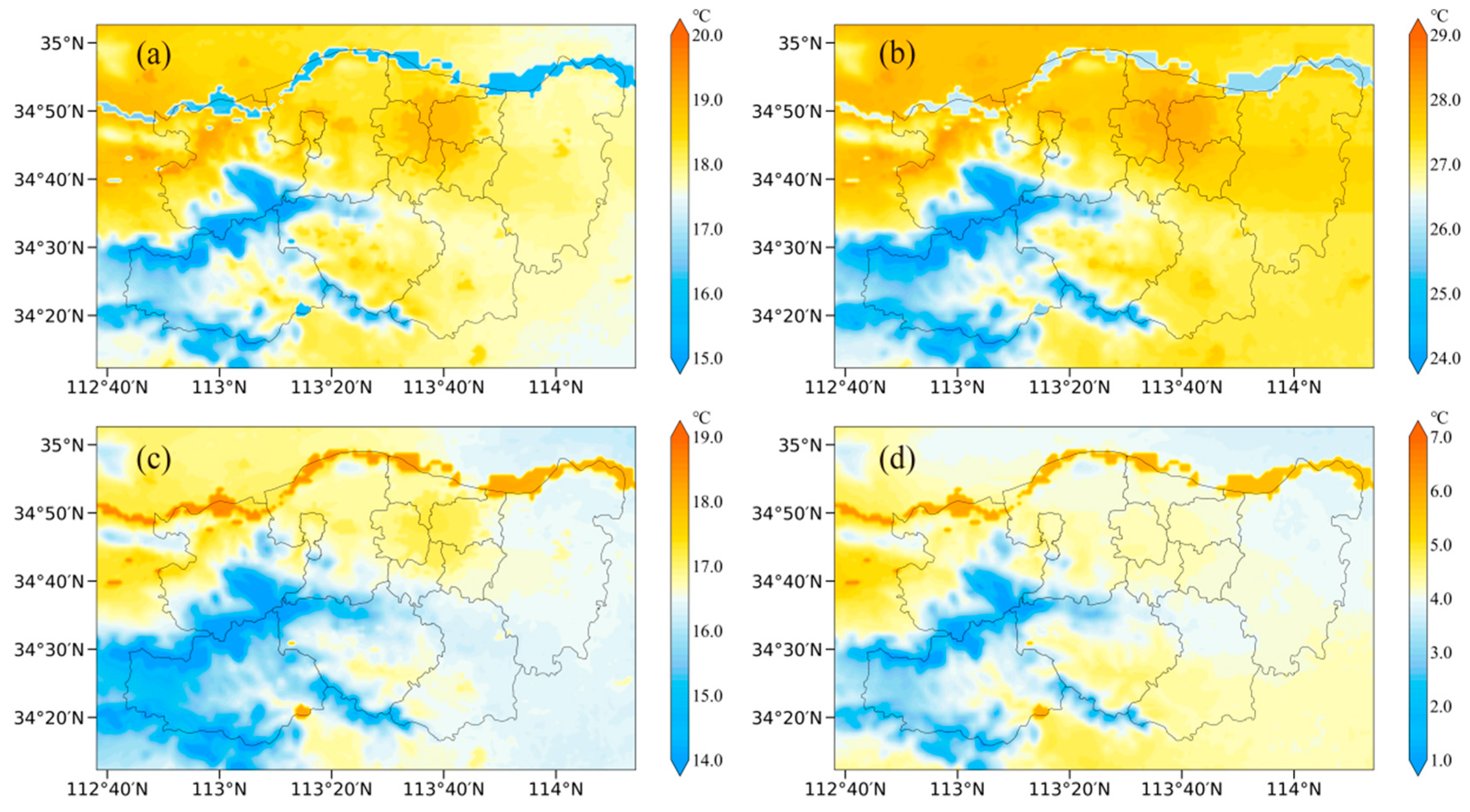
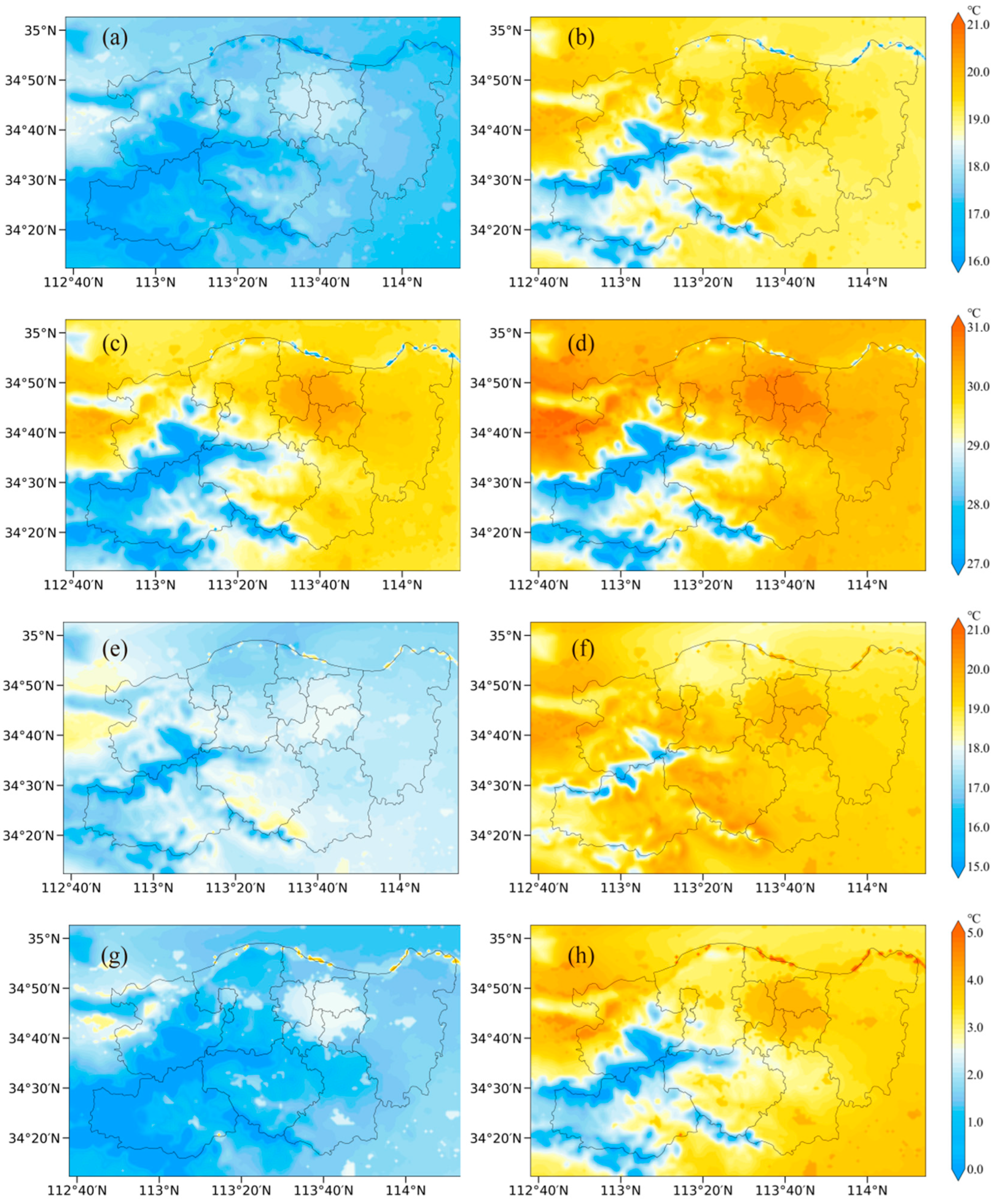
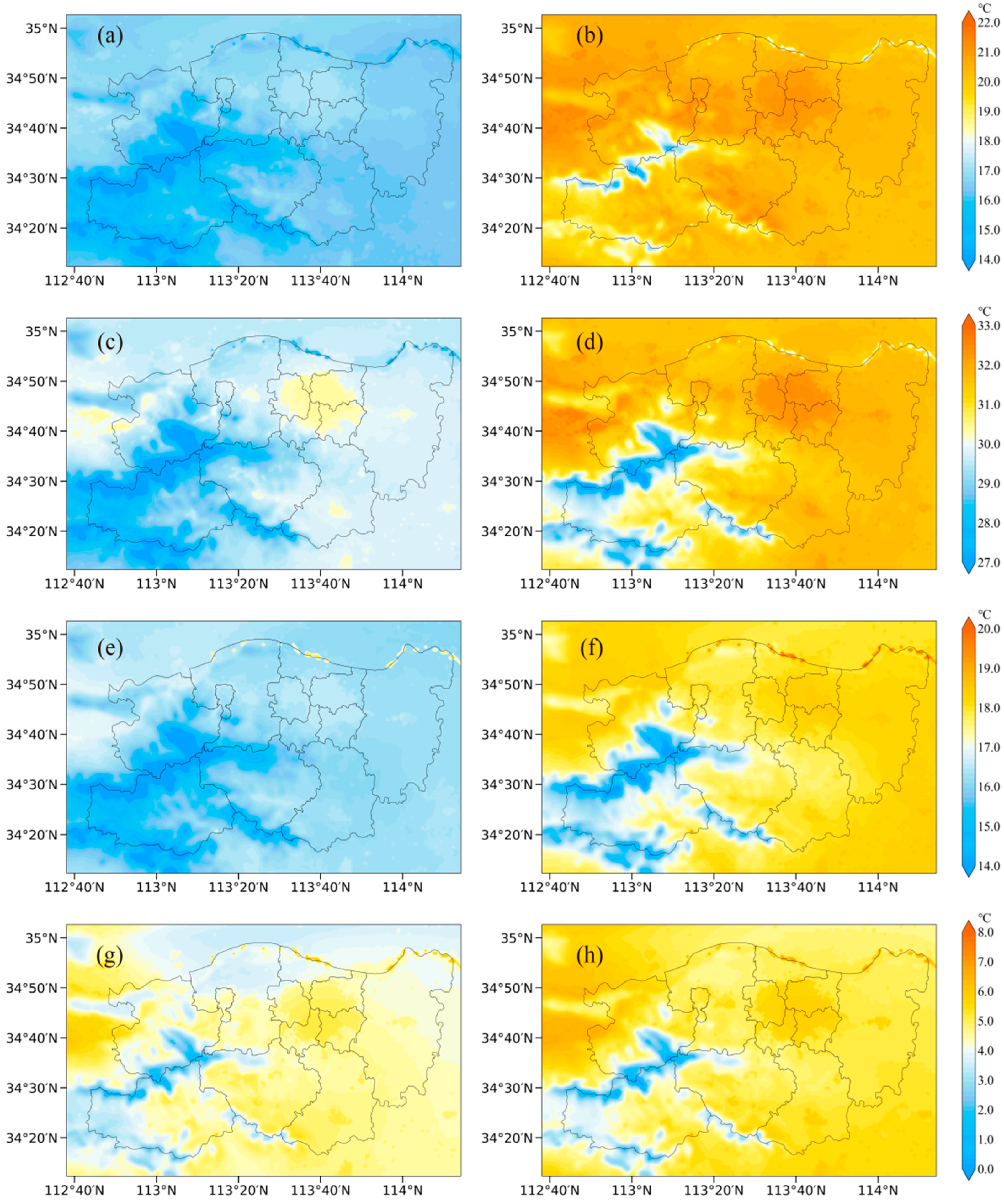
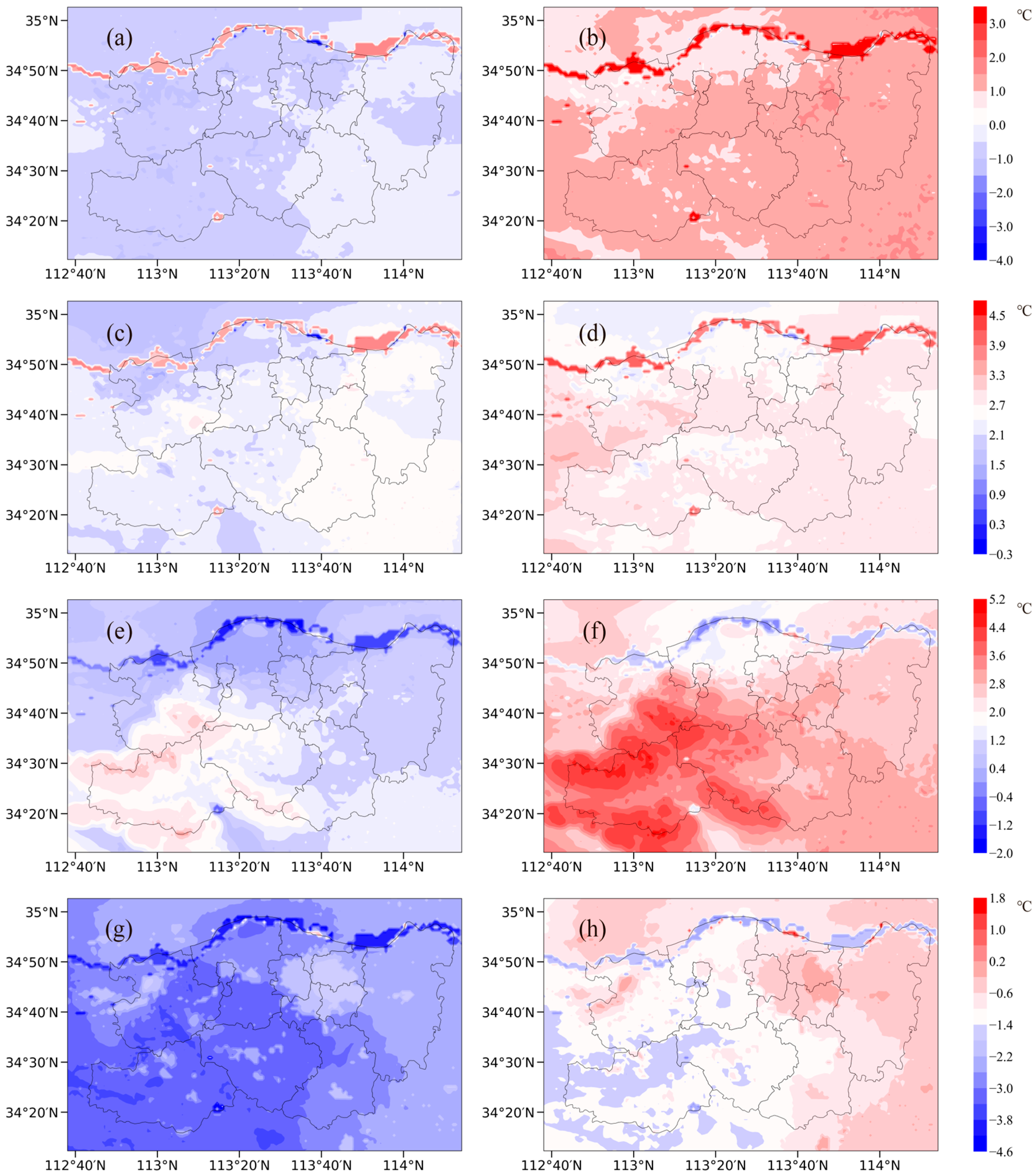

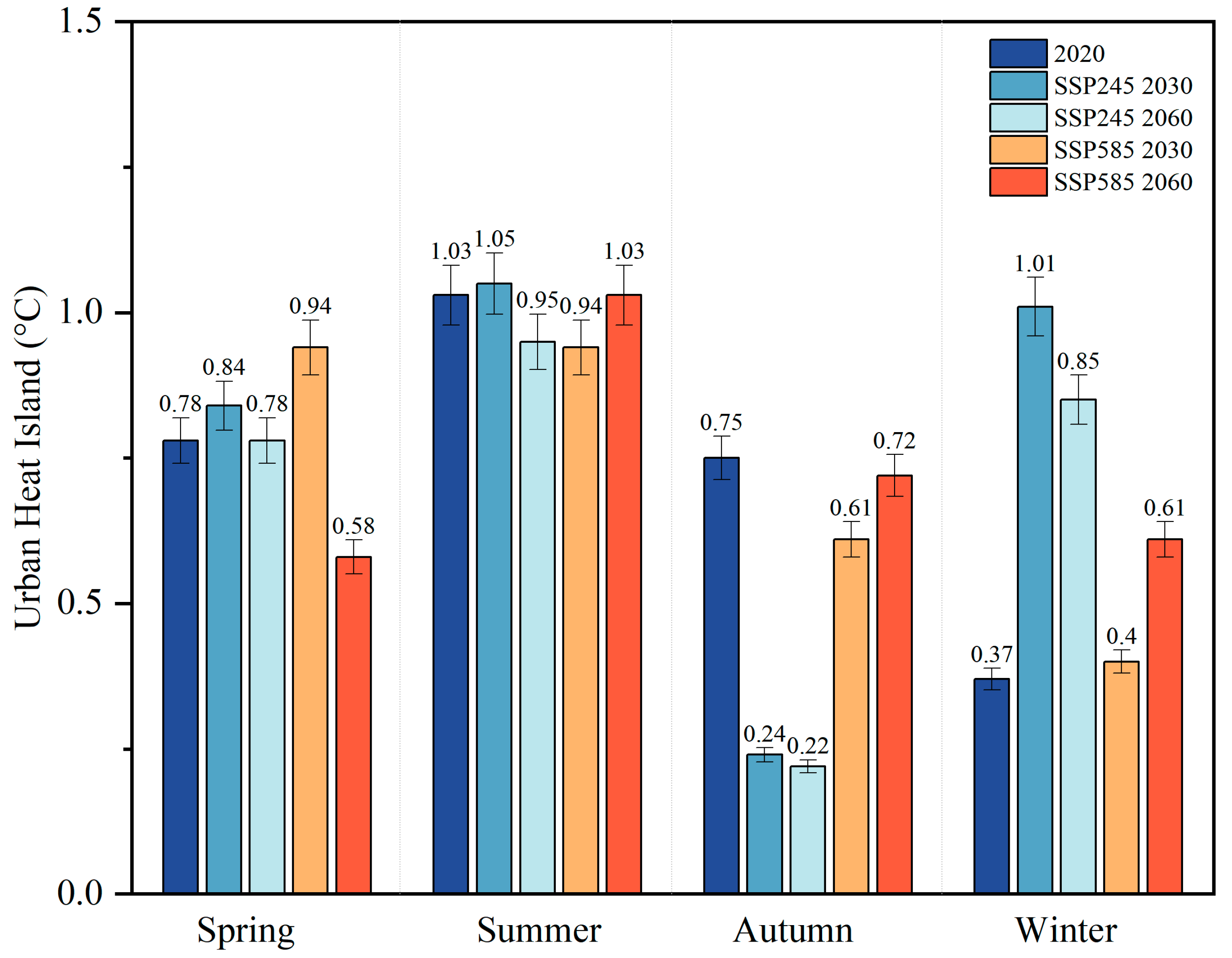
| Physical Options | Parameterization Schemes |
|---|---|
| Microphysics | Lin [38] |
| Longwave radiation | Goddard [39] |
| Shortwave radiation | Goddard [40] |
| Land surface | Unified Noah [41] |
| Surface layer | Eta [42] |
| Planetary boundary | Mellor–Yamada–Janjic TKE [43] |
| Cumulus | Kain–Fritsch (new Eta) [44] |
| Experiment | Land Use and Cover Data | Climate Data |
|---|---|---|
| Baseline | 2020 | 2020 (NCEP) |
| 1 | 2030 (SSP245) | 2030 (SSP245) |
| 2 | 2030 (SSP585) | 2030 (SSP585) |
| 3 | 2060 (SSP245) | 2060 (SSP245) |
| 4 | 2060 (SSP585) | 2060 (SSP585) |
| Domain | MB (°C) | NMB (%) | NME (%) | RMSE (°C) | R |
|---|---|---|---|---|---|
| D01 | 0.60 | 4.13 | 8.70 | 2.47 | 0.97 |
| D02 | 1.15 | 7.83 | 10.39 | 4.16 | 0.92 |
| D03 | 0.08 | 0.50 | 10.27 | 2.11 | 0.98 |
| Time | MB (°C) | NMB (%) | NME (%) | RMSE (°C) | R |
|---|---|---|---|---|---|
| Spring | −0.05 | −0.28 | 11.41 | 2.53 | 0.95 |
| Summer | 0.71 | 2.73 | 6.98 | 2.25 | 0.87 |
| Autumn | −0.24 | −1.45 | 8.51 | 1.83 | 0.97 |
| Winter | −0.11 | −2.77 | 34.68 | 1.71 | 0.92 |
| Experiment | Spring | Summer | Autumn | Winter | ||||
|---|---|---|---|---|---|---|---|---|
| 2020 Baseline | 18.40 | 17.62 | 27.71 | 26.68 | 16.89 | 16.14 | 4.22 | 3.85 |
| 2030 (SSP245) | 17.85 | 17.01 | 30.06 | 29.01 | 17.64 | 17.40 | 1.93 | 0.92 |
| 2030 (SSP585) | 16.87 | 15.93 | 30.00 | 29.06 | 16.37 | 15.76 | 4.62 | 4.20 |
| 2060 (SSP245) | 19.59 | 18.81 | 30.42 | 29.47 | 19.36 | 19.14 | 3.63 | 2.78 |
| 2060 (SSP585) | 20.72 | 20.14 | 32.01 | 30.98 | 18.12 | 17.40 | 5.38 | 4.77 |
Disclaimer/Publisher’s Note: The statements, opinions and data contained in all publications are solely those of the individual author(s) and contributor(s) and not of MDPI and/or the editor(s). MDPI and/or the editor(s) disclaim responsibility for any injury to people or property resulting from any ideas, methods, instructions or products referred to in the content. |
© 2025 by the authors. Licensee MDPI, Basel, Switzerland. This article is an open access article distributed under the terms and conditions of the Creative Commons Attribution (CC BY) license (https://creativecommons.org/licenses/by/4.0/).
Share and Cite
Ni, X.; Chang, Y.; Bai, T.; Liu, P.; Song, H.; Wang, F.; Jin, M. Projections of Urban Heat Island Effects Under Future Climate Scenarios: A Case Study in Zhengzhou, China. Remote Sens. 2025, 17, 2660. https://doi.org/10.3390/rs17152660
Ni X, Chang Y, Bai T, Liu P, Song H, Wang F, Jin M. Projections of Urban Heat Island Effects Under Future Climate Scenarios: A Case Study in Zhengzhou, China. Remote Sensing. 2025; 17(15):2660. https://doi.org/10.3390/rs17152660
Chicago/Turabian StyleNi, Xueli, Yujie Chang, Tianqi Bai, Pengfei Liu, Hongquan Song, Feng Wang, and Man Jin. 2025. "Projections of Urban Heat Island Effects Under Future Climate Scenarios: A Case Study in Zhengzhou, China" Remote Sensing 17, no. 15: 2660. https://doi.org/10.3390/rs17152660
APA StyleNi, X., Chang, Y., Bai, T., Liu, P., Song, H., Wang, F., & Jin, M. (2025). Projections of Urban Heat Island Effects Under Future Climate Scenarios: A Case Study in Zhengzhou, China. Remote Sensing, 17(15), 2660. https://doi.org/10.3390/rs17152660






